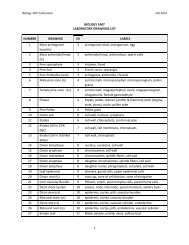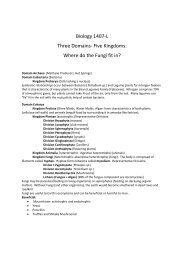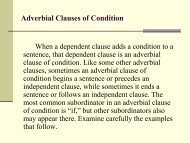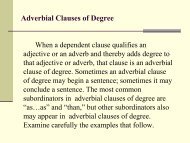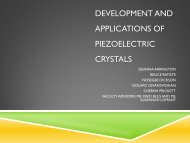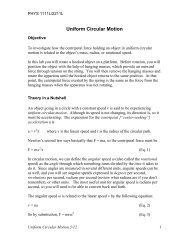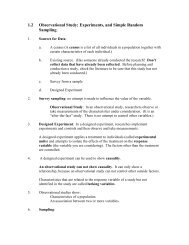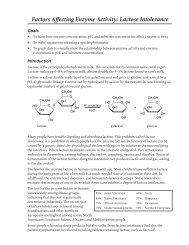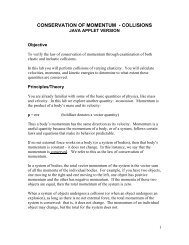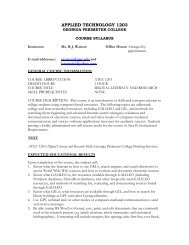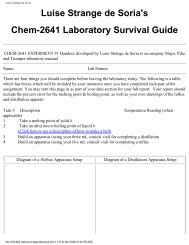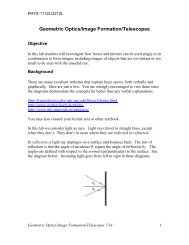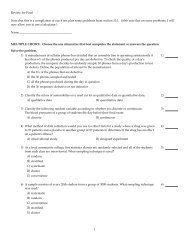Wittig Synthesis of trans-9-(2-phenylethenyl)
Wittig Synthesis of trans-9-(2-phenylethenyl)
Wittig Synthesis of trans-9-(2-phenylethenyl)
Create successful ePaper yourself
Turn your PDF publications into a flip-book with our unique Google optimized e-Paper software.
<strong>Wittig</strong> <strong>Synthesis</strong> <strong>of</strong> <strong>trans</strong>-9-(2-Phenylethenyl)anthracene<br />
(Used as the photosensitizer in Chemiluminescence)<br />
Last update: 22 August 2005<br />
Dr. Glenn Nomura<br />
Reference:<br />
Williamson, Macroscale and Microscale Organic Experiments, 4 th edition, Houghton Mifflin: New York, 2003,<br />
Experiment 39.1, (1 X) macroscale <strong>Synthesis</strong> <strong>of</strong> <strong>trans</strong>-9-(2-<strong>phenylethenyl</strong>)anthracene, p. 481<br />
Equation:<br />
CHO<br />
Cl -<br />
(C 6 H 5 ) 3 PH 2 C<br />
50% NaOH<br />
CH 2 Cl 2<br />
H<br />
H<br />
9-anthraldehyde<br />
C 15 H 10 O, 206.24<br />
mp 104-105 o C<br />
benzyltriphenylphosphonium chloride<br />
C 6 H 5 CH 2 P(C 6 H 5 ) 3 Cl, 388.88<br />
<strong>trans</strong>-9-(2-<strong>phenylethenyl</strong>)anthraldehyde<br />
C 22 H 16 , 280.37<br />
mp 131-132 o C<br />
Materials:<br />
1. 9-anthraldehyde, 0.57 g (0.00276 mol)<br />
2. benzyltriphenylphosphonium chloride, 0.97 g (0.00249 mol)<br />
3. 50% NaOH, 1.3 mL<br />
Procedure:<br />
<strong>Synthesis</strong> <strong>of</strong> <strong>trans</strong>-9-(2-<strong>phenylethenyl</strong>)anthracene<br />
This reaction should be performed in the hood.<br />
Into a 50 mL Erlenmeyer flask equipped with a stir bar is weighed 0.57 g (0.00276 mol) <strong>of</strong> 9-anthraldehyde, and<br />
0.97 g (0.00249 mol) <strong>of</strong> benzyltriphenylphosphonium chloride, and 5 mL <strong>of</strong> methylene chloride, CH 2 Cl 2 . To this is<br />
added with stirring at room temperature 1.5 mL <strong>of</strong> 50% NaOH solution dropwise from a Pasteur pipet (Note A).<br />
Continue to stir for 30 minutes; then <strong>trans</strong>fer the contents <strong>of</strong> the flask to a separatory funnel (pour liquids through a<br />
funnel at the top <strong>of</strong> the separatory funnel) using about 10 mL <strong>of</strong> water and 10 mL <strong>of</strong> methylene chloride, CH 2 Cl 2<br />
(Note B). Shake the mixture, drain the lower methylene chloride layer (Note C), and extract the aqueous layer<br />
again with 5 mL <strong>of</strong> methylene chloride. Dry the combined methylene chloride layers with anhydrous Na 2 SO 4 .<br />
Decant the methylene chloride to a clean dry 50 mL Erlenmeyer flask, being careful to leave the Na 2 SO 4 behind.<br />
Use additional methylene chloride to complete the <strong>trans</strong>fer. In the hood, evaporate the methylene chloride (bp<br />
40°C) to dryness on a sand bath (Note D). A brownish-yellow solid should result at this point.<br />
Recrystallization <strong>of</strong> <strong>trans</strong>-9-(2-<strong>phenylethenyl</strong>)anthracene While the flask is still warm, add 15 mL <strong>of</strong><br />
2-propanol (isopropyl alcohol) to the 50 mL Erlenmeyer flask above. Warm the flask in the sand bath to dissolve<br />
the solid (remember to keep the flask covered with foil or cotton). Place the flask on a paper towel and place an<br />
inverted beaker over the flask to protect it from cold drafts (Note E). Distinct yellow platelets should crystallize in<br />
about 15 minutes. Filter the crystals on a Buchner funnel set up at your bench (remember to clamp the filter flask on<br />
a ring stand to prevent tipping and breakage). Recycle the isopropyl alcohol filtrate from the filter flask to complete<br />
the <strong>trans</strong>fer <strong>of</strong> crystals onto the Buchner funnel. Rinse the crystals one last time with fresh cold isopropyl alcohol to<br />
clean the outer surface <strong>of</strong> the crystals. Air dry the crystals on filter paper, determine the yield and mp, and turn in<br />
the final product (Note F).<br />
- A UV light is available in the lab for examining the isopropyl filtrate – IT GLOWS! -
Exp 39.1 <strong>Wittig</strong> <strong>Synthesis</strong> <strong>of</strong> <strong>trans</strong>-9-(2-Phenylethenyl)anthracene 2<br />
Final Steps:<br />
1. Determine the % yield <strong>of</strong> <strong>trans</strong>-9-(2-<strong>phenylethenyl</strong>)anthracene.<br />
2. Determine the mp.<br />
3. Turn in your product in a labeled vial.<br />
Notes:<br />
A. The dropwise addition <strong>of</strong> 1.5 mL <strong>of</strong> 50% NaOH should take about 1-2 minutes.<br />
B. The exact amount <strong>of</strong> water and methylene chloride required for quantitative <strong>trans</strong>fer <strong>of</strong> the reaction is<br />
not critical. What is important is that the <strong>trans</strong>fer be complete.<br />
C. Normally, organic layers are the upper layer. Halogenated solvents such as methylene chloride are<br />
higher density than water and will be the lower layer.<br />
D. There is no danger <strong>of</strong> evaporating the product during the evaporation <strong>of</strong> methylene chloride step, but<br />
be certain to set the sand bath temperature to a moderate temperature sufficient to evaporate the<br />
methylene chloride, which boils at 40°C. Too high a sand bath temperature can cause the <strong>Wittig</strong><br />
product to decompose and blacken, especially after the solvent has completely evaporated and the flask<br />
is allowed to become hot.<br />
E. When recrystallizing any compound, always allow the solution to cool slowly on its own in the<br />
beginning. The paper towel and inverted beaker are precautions to help slow down the rate <strong>of</strong> cooling<br />
and allow fewer nucleating crystals to form at the beginning, which then grow to larger well formed<br />
crystals <strong>of</strong> high purity and predictable mp. If the solution is cooled too quickly, the solid will “crash”<br />
out <strong>of</strong> solution sometimes along with impurities into micro sized powder particles <strong>of</strong> lower quality.<br />
F. The mp is sufficient in this case to confirm the product.<br />
Waste & Clean Up:<br />
1. Into Mr. White: All aqueous washings; organic residues; and acetone rinses <strong>of</strong> dirty equipment<br />
2. Halogenated Waste: All mixtures <strong>of</strong> halogenated containing waste, i.e. methylene chloride, CH 2 Cl 2 .<br />
Prep Room Instructions:<br />
For a class <strong>of</strong> 24 students<br />
1. 9-anthraldehyde 15 g<br />
2. benzyltriphenylphosphonium chloride 25 g<br />
3. 50% NaOH 40 mL<br />
4. stir bars 24<br />
5. anhydrous Na 2 SO 4 bottle<br />
6. pentane 500 mL<br />
7. methylene chloride, CH 2 Cl 2 500 mL<br />
8. 2-propanol 500 mL<br />
9. 42.5 mm filter paper box



